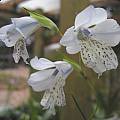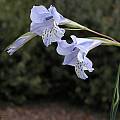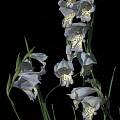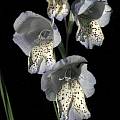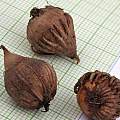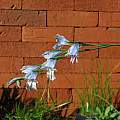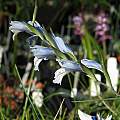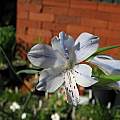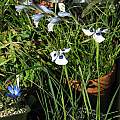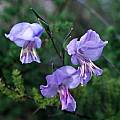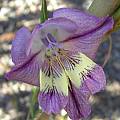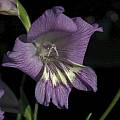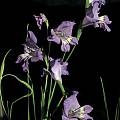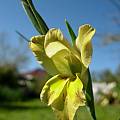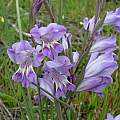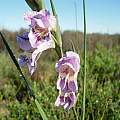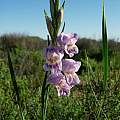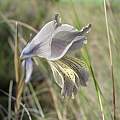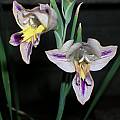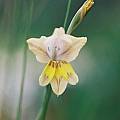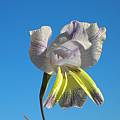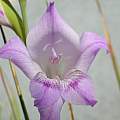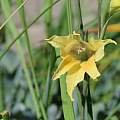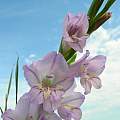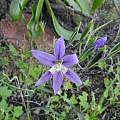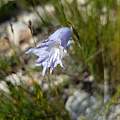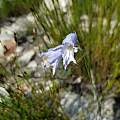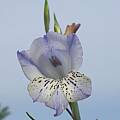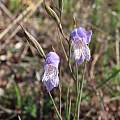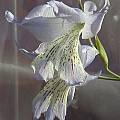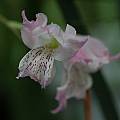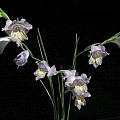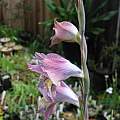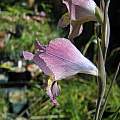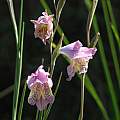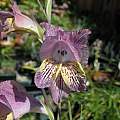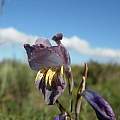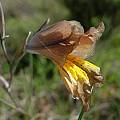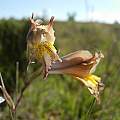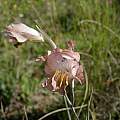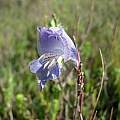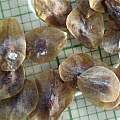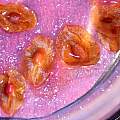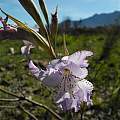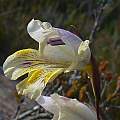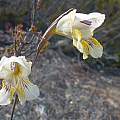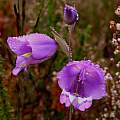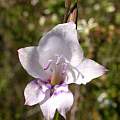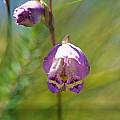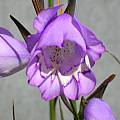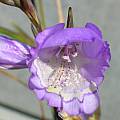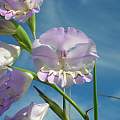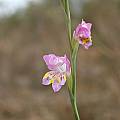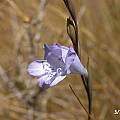Clear blue is rare among Gladiolus, but a few species still show variations in mostly pale tones. Please note that many species that are sometimes described as blue can be found in the Purple Gladiolus index.
Gladiolus caeruleus Goldblatt & J.C.Manning (syn. Gladiolus gracilis var. latifolia G.J.Lewis) is found on limestone outcrops and calcareous sands close to the coast in the Southwest Cape. The flowers are pale blue with dark speckles on the lower tepals. Plant height: 40-60 cm tall. It blooms in winter. Flower photos by Bob Rutemoeller, Mary Sue Ittner and Bob Werra. Corms from Telos Rare Bulbs by M. Gastil-Buhl on a 1 mm grid.
The photos below were taken by Nhu Nguyen of plants bought from Telos Rare Bulbs. The last photo shows a blue triad of this species with Moraea aristata and Tecophilaea cyanocrocus.
Gladiolus carinatus Aiton is found on sandstone slopes or deep coastal sands in many areas of the Cape. It flowers late winter to spring and can be blue to violet or yellow, rarely pink, often with yellow markings on the lower tepals. Height range: 30-60 cm high. The first two photos were taken by Mary Sue Ittner; the first photo was taken September 2001 in the Southwest Cape and the second shows the flower of a plant grown from seed and flowering March 2004. The next two were taken by Bob Werra. The last photo from Cameron McMaster shows a yellow form grown from seed by Rhoda McMaster.
The first five photos were taken in the Western Cape in Hopefield, Elands Bay, and near Napier by Cameron McMaster. The last photo is from Rod Saunders.
The photos from Alan Horstmann show different forms.
Gladiolus deserticola Goldblatt is restricted to the Richtersveld, a mountainous area of northern Namaqualand. Plants grow in sheltered sites, most frequently in clay soils on south-facing slopes protected by rock or shrubs. Flowers are dark blue with a darker line in the midline of the tepals. The lower tepals or the lateral lower tepals are cream edged with purple. Flowers are weakly rose scented. Height: 10-20 cm. Photo from Rachel Saunders who found a single specimen blooming in July 2011, a bit early for this species that usually blooms mid August to mid September.
Gladiolus exilis G.J.Lewis is a fall-blooming, winter-growing species from the mountains of the Western Cape where it grows in clay loam in fynbos. Growing from 25-45 cm tall, it has white to pale blue fragrant flowers with dark streaks on the lower tepals. It looks similar to Gladiolus gracilis. Photos from iNaturalist taken by Peter Thompson in the Western Cape in May and shared under a CC BY-NC license.
Gladiolus gracilis Jacq. is very similar to Gladiolus caeruleus, but is a bit smaller, has fewer flowers (2 to 5 in a spike), is usually blue to grey, but occasionally pink or yellowish and has dark streaks (instead of spots) on the lower tepals. The lowermost tepal is usually longer in this species instead of mostly the same length as the others in G. caeruleus. It is found mostly on clay slopes (or granite) and blooms in winter. Height range: 30-60 cm. The first two photos were taken by Alan Horstmann. The third was taken by Mary Sue Ittner March 2004 of flowers grown from Silverhill Seed and the fourth in 2007 of more seed grown plants, but this time one with pink flowers. The last photo was taken by Bob Werra
The photos below were taken by Nhu Nguyen of a plant from Telos Rare Bulbs.
All of the pictures below were taken by Cameron McMaster near Napier in the Overberg and illustrate the different forms possible.
The photos taken by M. Gastil-Buhl show seeds from Silverhill Seed dry on a 1 mm grid, then wet.
Gladiolus mutabilis (Harms) Goldblatt is an Eastern Cape species and also occurs in the eastern part of the Western Cape. Plants grow in sandstone derived soils. This species has slightly fleshy leaf blades without thickened margins or midribs and an elongated corm that is two to three times as long as wide. Flower color ranges from pale to dark blue, mauve, brown or cream. The lower tepals are usually cream or yellow below with dark blue or brown dots and streaks on the yellow background forming the nectar guide. The fragrant flowers appear early in the season, June or July. Height: 25-50 cm. The first photo was taken by Rachel Saunders who discovered this plant late July 2012 blooming in an area that had previously burned in the Western Cape. The next two photos were taken by Cameron McMaster August 2012 at the top of Potjiesberg Pass south of Uniondale (Eastern Cape) where it was growing with Gladiolus patersoniae. In the Western Cape population Gladiolus patersoniae was also in flower raising the question of whether they are both pollinated by the same pollinator. The last photo from the book Plants of the Klein Karoo courtesy of Jan and Anne Lise Schutte-Vlok.
Gladiolus rogersii Baker grows to 60 cm and has narrow leaves with a prominent midrib. Flowers are blue to purple with yellow or white transverse markings on the lower tepals. In the Kammanassie Mountains flowers can be cerise-pink. This is a widespread South African species found on sandstone and limestone slopes in winter and year round rainfall areas and mostly blooms in spring. There are variants that flower from autumn to early winter on the foothills of the mountains in the Little Karoo. The first two photos and information from the book Plants of the Klein Karoo courtesy of Jan and Anne Lise Schutte-Vlok. The third photo by Mary Sue Ittner was taken of a plant growing on a slope east of Swellendam. Most of the flowers had been eaten by an insect. Photos 4-6 were taken by Alan Horstmann.
Gladiolus subcaeruleus G.J.Lewis grows on sandy loam and clay slopes in renosterveld in the southwestern Cape and flowers in the fall. It is described as having pale blue to mauve flowers with yellow transverse to spear shaped markings outlined in purple on the lower tepals. The dorsal tepal is hooded over the stamens. Height range: 15-30 cm. Photos taken by Cameron McMaster in the Overberg, Bot River and Napier show variations.
